Theo Coughlin
August 20, 2023
Tharpaling Monastery
Nestled atop a mountain, overlooking the picturesque Chummey Valley in the heart of Bumthang, Bhutan, lies Tharpaling Monastery, a captivating haven known as “The Land of Liberation.” At an approximate elevation of 3600m, lying above the Gaytsa village, and only accessible by a dirt road, the monastery is hard to traverse in the summer or monsoon season. This architectural marvel embodies not only the charm of its physical form but also a captivating narrative that interweaves myth, history, and spirituality. As the sun’s gentle rays paint the monastery in a golden hue, let’s embark on a journey to uncover the multifaceted layers that define this sacred sanctuary. At first glance, Tharpaling Monastery is a breathtaking sight to behold. Its intricate design harmonizes the echoes of bygone eras with the contemporary pulse of the present. Beyond its physical allure, however, lies a narrative as captivating as the building itself—an intricate dance of past and present, masculine and feminine, master and disciple.
Longchenpa’s Personal History
To truly fathom the mythic origins of Tharpaling, one must delve into the story of its legendary founder, Longchenpa. Born in the year 1308 in the mystical lands of Tibet, Longchenpa’s very essence is intertwined with that of Princess Pemasel, who, through the divine grace of Padmasambhava, received the pioneering teachings of “Seminal Heart of the Dakinis.” These teachings passed through the hands of reincarnations and found their eventual home in Longchenpa’s consciousness. His incarnation as Pemasel marks a captivating juxtaposition between gender and age—Pemasel, merely eight years old at her passing, defies the confines of both age and gender. Intriguingly, Longchenpa’s spiritual journey introduces us to a cohort of Yoginis, female yogis, who walked the path alongside him. This bold inclusion shifts the traditional power dynamic, as these Yoginis—embodiments of the divine feminine—possess their disciples, transmitting teachings and guidance. Longchenpa’s hailing from Princess Pemasel and special relation with the Yoginis shapes the unique character of Tharpaling Monastery, blending tradition with innovation.
The chronicles of Longchenpa’s life further unravel as he evolves into a teacher at the Gompa Kunrig of Drikung—a significant rival to the then-Tibetan king, Tai Situ. The shadows of power and rivalry cast an assassination attempt on Longchenpa, a peril he miraculously escapes through his ability to become invisible. This dramatic turn of events propels him into self-imposed exile in Bhutan, where he finds solace in the embrace of Samling village in Bumthang.
It is within the embrace of this Bhutanese haven that Longchenpa’s connection with Tharpaling Monastery truly takes root. A site initially consecrated by Guru Rinpoche in the eighth century, the sacred echoes of its history resonate through time. Guru Rinpoche’s meditative presence upon this hallowed ground, as he descended upon a tigress, still lingers—an indelible mark etched in the very rock.
Lorepa to Longchenpa
Tharpaling’s evolution is intricately woven with the lineage of mythic Buddhist masters. The foundation laid by Lorepa in the thirteenth century merged seamlessly with Longchenpa’s contribution, despite the divergence of their schools—the former hailing from the Drukpa Kagyu tradition and the latter a revered figure of the Nyingma tradition. This harmonious amalgamation birthed a sanctuary transcending sectarian boundaries—a welcoming abode for Nyingma and Kagyu scholars alike.
Tharpaling Monastery embodies the dichotomy of Longchenpa’s journey—defying established roles and affiliations. This monumental structure stands as his refuge, resonating with an ethos of acceptance—a living tribute to a treasure revealer beloved by the centuries.
Today, Tharpaling’s allure remains undiminished, attracting Bhutanese pilgrims and spiritual seekers from afar. Its moniker, “The Land of Liberation,” captures the essence of the transformations that transpire within its sacred confines. It is said that the air itself carries the whispers of Longchenpa’s teachings, inviting visitors to partake in a journey of inner enlightenment.
Additional History
In later years, the temples inside the monastery fell into disrepair, losing their significance over the passing centuries. At the start of the 20th century, King Ugyen Wangchuck and the revered sage Tokden Shakya Shri undertook the restoration. They established a retreat center with thirteen practitioners, breathing new life into the sacred site. Following this, a Buddhist scholar named Kuentop further enhanced the center, elevating it to the status of a monastic institution. This catalyzed additional development, resulting in a significant monastic community that encompassed both the Kagyu and Nyingma sects of Buddhism.
Adjacent to the old temple stands a modest shrine, believed to have once been the residence of Bhutan’s inaugural monarch, Ugyen Wangchuck. It is thought that he engaged in meditation within the Tharpaling area. The second king, Jigme Wangchuck, continued this legacy by overseeing substantial renovation efforts, ensuring the preservation of the site’s sacredness.
Inside the Monastery
Tharpaling Monastery holds a fascinating relic—the “Great Cannon of Tharpaling,” a stone sculpture. Positioned to face a village and resembling a female form, it once stirred concerns for the monastery’s sanctity, associated with monks forsaking their vows. However, the erection of the Great Cannon seemingly resolved the issue, restoring harmony. This sculpted enigma mirrors the delicate balance between spirituality and the tangible world, embodying the monastery’s resilience. Today, it stands as a testament to the interplay between tradition and adaptation, a symbol of transformation within Tharpaling’s sacred domain.
As the world changes, Tharpaling endures, an eternal witness to the passage of time. Restored by the visionary efforts of Bhutan’s first king, Ugyen Wangchuck, in the twentieth century, the monastery has grown to be a bastion of Nyingma teachings, radiating a spiritual energy that draws seekers into its embrace. In fact, for most of its existence, Tharpaling was the only and premier destination for Nyingma monks to study in Bhutan, losing that role in recent times with the development of a monastic college at Gangteng Monastery.
Above the monastery, Jangchub Choeling Shedra, a monastic school, was established, perpetuating the legacy of knowledge. And further up the mountain, Chodrak Monastery stands at 3800 m—a site where Guru Rinpoche is said to have meditated. Even further up, there are meditation caves graced by Longchenpa and Guru Rinpoche, one where Longchenpa’s devotion transmuted into three years, three months, three weeks, and three days of meditation. At the top of the mountain, there is a rock where Longchenpa is supposed to have written part of the Seven Treasures, encapsulating centuries of Tibetan Buddhist thought and etching his legacy into the very essence of the rock.
Contemporary Times
In the present day, a monumental tribute to Longchenpa graces that very spot, where a magnificent statue of him stands encased within a protective, transparent structure. This awe-inspiring statue takes its place at the mountain’s zenith, commanding a panoramic view that stretches across two distinct valleys—Chhoekhor Gewog and Jakar—and the enchanting Chummey Valley. This is no easy walk, though, as visitors must walk up a steep trail, gaining hundreds of feet of elevation over a short distance. From this elevated vantage point, Longchenpa’s presence seems to transcend time, gazing upon the tranquil landscapes that have witnessed the passage of centuries. It is as though the statue acts as a guardian, embracing the legacy of Longchenpa and symbolically uniting the wisdom he shared with the profound beauty of the Bhutanese terrain.
Visiting Tharpaling
Nestled within the core of Tharpaling Monastery, the spirit of devotion envelopes two essential temples. The Tshongkhang temple, gracing the lower level, invites visitors with its collection of statues, including the esteemed Longchen Rabjam and Guru Rinpoche. Ascending to the upper floor, a more intimate temple, meticulously restored during King Ugyen Wangchuck’s time reveals a series of captivating paintings portraying a celestial realm where Longchen Rabjam and Zhabdrung Ngawang Namgyel abide. Statues of Guru Rinpoche, Samantabhadra, and Longchen Rabjam oversee this celestial atmosphere. (Above this is a small temple with a shorten containing the remains of Nyoshul Rinpoche [1932-1999].)
The assembly hall, a hub of the monastic school, becomes an artful canvas narrating the stories of the Sixteen Arhats and the lineage of Longchen Rabjam, a visual tapestry that radiates life. Beneath the monastery’s serene complex, a row of eight chortens stands aligned, a reverential homage to the significant milestones of Buddha’s journey. This harmonious arrangement adds an aura of sanctity, echoing Tharpaling Monastery’s profound reverence for its sacred heritage.
Sacred Grounds
Tharpaling Monastery is more than a structure—it is a living testament to devotion, resilience, and the transcendence of time. The sacredness of its grounds extends beyond physical boundaries as if the mountain itself cradles the monastery in its embrace. Indeed, Tharpaling transcends its material form, a manifestation of Longchenpa’s enduring spirit and the collective devotion of generations. In every whispering wind and every sunlit corner, Longchenpa’s presence is palpable—a guardian of enlightenment, a beacon of wisdom. As pilgrims tread the path paved by the legendary figure of Longchenpa, they receive the spirit of acceptance, transformation, and of liberation that defines the very essence of Tharpaling Monastery. This sacred haven continues to welcome all who seek, beckoning with its exquisite charm, and reminding us that within its storied walls, the spirit is forever unshackled, forever liberated—a timeless journey of the soul.
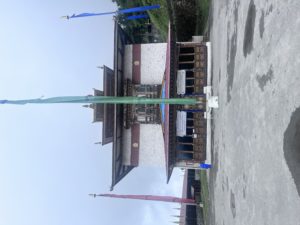
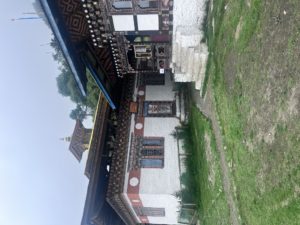
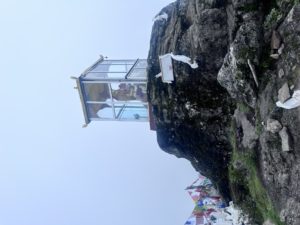
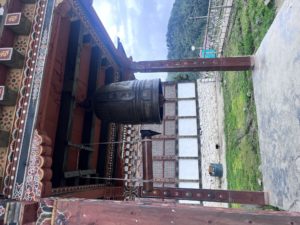

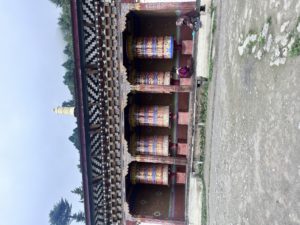
Bibliography
“Encyclopedia of Religion.” Encyclopedia.Com. 25 Jul. 2023 <https://Www.Encyclopedia.Com>.” Encyclopedia.com, August 20, 2023. https://www.encyclopedia.com/environment/encyclopedias-almanacs-transcripts-andmaps/ klong-chen-rab-byams-pa-longchenpa.
Exposure, Bhutan Life. “Home.” Bhutan Life Exposure. Accessed August 19, 2023. https://www.bletour.com/location/tharpaling-monastery/.
Pommaret, Francoise (2006). Bhutan Himalayan Mountains Kingdom (5th ed.). Odyssey Books and Guides. p. 223.
“Tharpaling Lhakhang.” Association of Bhutanese Tour Operators. Accessed August 19, 2023. http://abto.org.bt/destinations/bumthang/tharpaling-lhakhang/.
“Tharpaling Monastery.” Chung Tulku Rinpoche. Accessed August 19, 2023. https://chungtulkurinpoche.blogspot.com/p/about-tharpaling-monastery.hml.
“Tharpaling Monastery: Attractions in Bumthang.” BookMyTour. Accessed August 19, 2023. https://www.bookmytour.bt/attractions/tharpaling-monastery.
“Tharpaling.” The Treasury of Lives. Accessed August 19, 2023. https://treasuryoflives.org/institution/Tharpaling.